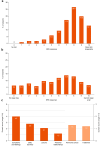Rocatinlimab Improves Patient-Reported Outcomes in Adults with Moderate-to-Severe Atopic Dermatitis: Results from a Double-Blind Placebo-Controlled Phase 2b Study
- PMID: 39532780
- PMCID: PMC11604902
- DOI: 10.1007/s13555-024-01303-z
Rocatinlimab Improves Patient-Reported Outcomes in Adults with Moderate-to-Severe Atopic Dermatitis: Results from a Double-Blind Placebo-Controlled Phase 2b Study
Abstract
Introduction: In adults with moderate-to-severe atopic dermatitis (AD), rocatinlimab demonstrated significant and progressive improvement in clinical measures of disease severity compared with placebo. This post hoc analysis of a phase 2b study was undertaken to understand the disease burden and to assess the impact of rocatinlimab on patient-reported outcomes (PROs).
Methods: This analysis used baseline data from a multicenter, randomized, double-blind study of adults with moderate-to-severe AD, who completed a Worst Pruritus numerical rating scale (NRS), Sleep Disturbance NRS, and the Dermatology Life Quality Index (DLQI). A mixed model for repeated measures was used to estimate changes in PRO scores from baseline; scores were also compared with clinically meaningful change benchmarks.
Results: The analysis included 267 subjects, mean (SD) age 37.9 (14.7) years, 40.8% female; 55.1% grade 3 and 44.9% grade 4 Investigator Global Assessment for AD. Mean (SD) scores were: Worst Pruritus NRS 7.5 (1.9), Sleep Disturbance NRS 5.5 (2.9), DLQI total score 12.6 (7.1). Worst Pruritus and Sleep NRS scores had low positive correlations with SCORing AD (SCORAD) score (r = 0.44, r = 0.45 respectively) and negligible correlations with Eczema Area and Severity Index (EASI) score and area affected (r < 0.30). DLQI score varied by sex, study country, race, age, longer disease duration, disease severity (EASI and SCORAD), presence of asthma, and Worst Pruritus NRS, Sleep disturbance NRS, and DLQI scores. Rocatinlimab showed benefit on all three PROs, with significant improvements from baseline at the end of the double-blind period (week 18) and active treatment extension (week 36). Benefits were maintained over 20 weeks' post-treatment follow-up. The benefit of rocatinlimab treatment on PROs is rapid and maintained for at least 20 weeks following treatment completion.
Conclusion: This analysis demonstrates the importance of characterizing the burden of moderate-to-severe AD from the patient's perspective, alongside clinical disease measures, to develop a fuller picture of treatment benefit.
Trial registration: ClinicalTrials.gov identifier, NCT03703102.
Keywords: Atopic dermatitis; Dermatology Life Quality Index; Health-related quality of life (HRQL); Pruritus; Rocatinlimab; Sleep disturbance.
© 2024. The Author(s).
Conflict of interest statement
Declarations. Conflicts of Interest: Melinda Gooderham has been an investigator, speaker, and/or advisor for: AbbVie, Acelyrin, Alumis, Amgen, Akros, Arcutis, Aristea, AnaptysBio, Apogee Therapeutics, Bausch Health, Bristol Myers Squibb, Boehringer Ingelheim, Cara Therapeutics, Dermira, Dermavant, Eli Lilly, Galderma, GSK, Incyte, Inmagene, JAMP Pharma, Janssen, LEO Pharma, L’Oreal, MedImmune, Meiji, MoonLake, Nektar, Nimbus, Novartis, Pfizer, Regeneron, Sanofi Genzyme, Sun Pharma, Tarsus, Takeda, UCB, Union, Ventyx, and Vyne. Emma Guttman-Yassky is an employee of Mount Sinai; this institution has received research grants from: LEO Pharma, Pfizer, Amgen, GSK, Incyte, Sanofi, Bristol Myers Squibb, ASLAN, Regeneron, AnaptysBio, Concert, Janssen, Q32 Bio, AbbVie, Eli Lilly, Arcutis, and Inmagene. Emma Guttman-Yassky has been a consultant for: AbbVie, Arcutis, Almirall, Amgen, AnaptysBio, Apogee Therapeutics, Apollo Therapeutics Limited, Artax Biopharma Inc., Astria, Bristol Myers Squibb, Boehringer Ingelheim, Calliditas Therapeutics, Cara Therapeutics, Celldex, Centrexion Therapeutics Corporation, Connect Biopharma, Coty, DBV Technologies, Eli Lilly, Enveda Biosciences, Escient Pharmaceuticals, Inc., Fairmount Funds Management LLC, FL2022-001, Inc., Galderma, Gate Bioscience, Google Ventures (GV), GSK Immunology, Incyte, Inmagene, Janssen Biotech, Jasper Therapeutics, Kymera Therapeutics, Kyowa Kirin, Leo Pharma, Matchpoint Therapeutics, Merck, Nektar Therapeutics, Novartis Pharmaceuticals, NUMAB Therapeutics AG, Nuvig, OrbiMed Advisors LLC, Otsuka, Pfizer, Pharmaxis Ltd, Pioneering Medicine VII, Inc., Proteologix US Inc., RAPT, RayThera, Inc., Regeneron Pharmaceuticals, RibonTherapeutics, Inc., Sagiment Biosciences, Sanofi, SATO, Schrödinger, Inc., Sitryx, Sun Pharma Advanced Research Company (SPARC), Takeda, Teva Branded Pharmaceutical Products R&D, Inc., TRex, UCB, and Ventyx Biosciences. Ken Igawa has received a lecture fee from: Sanofi, AbbVie, Lilly, Leo Pharma, Maruho, and Otsuka. Kenji Kabashima has received consulting fees, honoraria, grant support, and/or lecturing fees from: Amgen, Kyowa Kirin, Japan Tobacco, LEO Pharma, Maruho, Mitsubishi Tanabe, Ono Pharmaceutical, Procter & Gamble, Sanofi, Taiho, and Torii Pharmaceutical. Ehsanollah Esfandiari, Angela J Rylands and Angela Williams are employees of Kyowa Kirin International. Ehsanollah Esfandiari has stock options in Kyowa Kirin. Annabel Nixon and Jennifer E. Dent work for Chilli Consultancy, which received payment from Kyowa Kirin International for this work. Eric Simpson received personal fees from AbbVie, Amgen, Arcutis, Areteia Therapeutics, Bristol Myers Squibb, CorEvitas, Corvus, Dermira, Eli Lilly, Evelo Biosciences, FIDE, Forte Bio RX, Galderma, GlaxoSmithKline, Gilead Sciences, Impetus Healthcare, Incyte, Innovaderm Research, Janssen, Johnson & Johnson, Kyowa Kirin Pharmaceutical Development, LEO Pharma, Merck, NUMAB Therapeutics AG, Pfizer, Physicians World LLC, PRImE, Recludix Pharma, Regeneron, Roivant, Sanofi Genzyme, Sitryx Therapeutics, Trevi Therapeutics, and Valeant. Eric Simpson received research grants from or served as a principal investigator for: AbbVie, Acrotech, Amgen, Arcutis, ASLAN, Castle, CorEvitas, Dermavant, Dermira, Incyte, Lilly, Kymab, Kyowa Kirin, National Jewish Health, LEO Pharma, Pfizer, Regeneron, Sanofi, Target, and VeriSkin. Ethical Approval: The trial was conducted in accordance with the Declaration of Helsinki, the International Conference on Harmonization consolidated Good Clinical Practice guideline, and any applicable national and local laws and regulations. The protocol and all subsequent amendments were reviewed and approved by institutional review boards or independent ethics committees at each site. All subjects provided written informed consent.
Figures




References
-
- Silverberg JI, Gelfand JM, Margolis DJ, et al. Patient burden and quality of life in atopic dermatitis in US adults: a population-based cross-sectional study. Ann Allergy Asthma Immunol. 2018;121(3):340–7. - PubMed
-
- Silverberg J, Gelfand JM, Margolis DJ, et al. Pain is a common and burdensome symptom of atopic dermatitis in United States adults. J Allergy Clin Immunol Pract. 2019;7(8):2699-706.e7. - PubMed
Associated data
LinkOut - more resources
Full Text Sources
Medical
Miscellaneous

